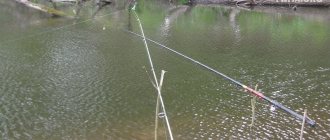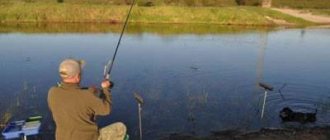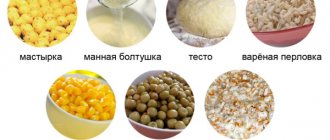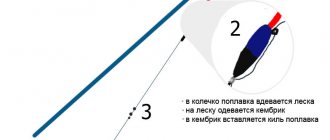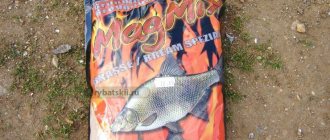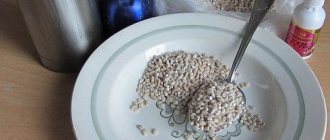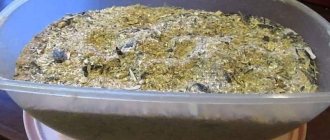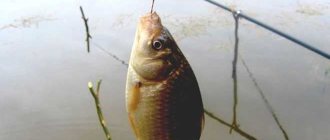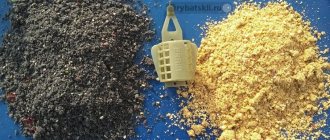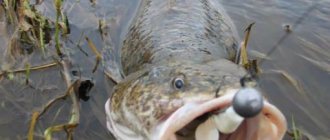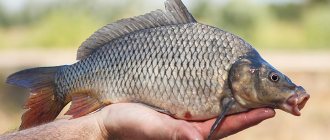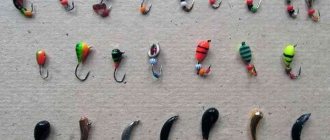The ide fish is very interesting for a number of reasons. It is not found in all bodies of water, it is quite cautious and timid, and its meat has good taste. These, as well as many other reasons, determine the popularity of ide among fishermen. The fish is also interesting because it can be caught with almost any gear - ide eats both plant and animal components, and therefore can be caught not only with fishing rods for peaceful fish, but also with fly fishing and spinning gear designed for catching predators. And if in the last two methods baiting is usually not practiced, then in the case of float and bottom fishing, the use of suitable purchased bait, as well as the use of various homemade bait mixtures can significantly affect the result. It should be taken into account that depending on the season, the bait for ide is different.
What are the features of ulcer bait?
Many anglers who have many years of experience in fishing for ide talk about the fact that bait containing bream compositions may be suitable for catching ide. At the same time, the ide bait must include a variety of very small components; ide loves cereal additives.
To catch ide, according to experienced fishermen, you can take bream or roach bait; in some cases, universal store-bought bait works well. At the same time, when fishing on currents, it is better to use store-bought baits with the inscription “For the river”, but for fishing on calm bodies of water, universal baits are suitable.
Ides especially like bait additives such as steamed wheat and pearl barley, and corn. But the most favorite component of ulcer bait is considered to be peas, and any peas can be cooked to add to the bait; if you use peas as bait, then you need to use only whole peas.
Breadcrumbs, dried and ground black bread are also added to the ulcer bait mixture; a little dry milk also doesn’t hurt. Some fishermen actively use oatmeal porridge to create ulcer bait, and also add crushed worms, maggots or bloodworms, or all of them together at once. But the makha is not always suitable for catching ide.
What baits are suitable for fishing ide
Most often, bream compositions are suitable for ide. Fine-grain components and grains must be added to bait. The structural features of the mouth eloquently tell us that the ide feeds from the bottom and in the water column. This is not bream or carp, which “vacuum the entire bottom” with their mouths. This is a very important point that should always be taken into account when preparing bait mixture.
Bream, roach and universal store-bought compounds are added to the bait. If we fish in the current, we use mixtures labeled “River”. When fishing in calmer areas, universal mixtures are used. Steamed wheat, pearl barley, and corn are added as grains.
We can definitely say that the best bait and vegetable bait is peas. If it is needed for bait, then it is boiled whole, but for bait, half will do.
Breadcrumbs, black bread, milk powder, rolled oats, maggots and chopped worms are also added to the mixture. As for makukha, it is not suitable for all bodies of water. You need to know the preferences of ide in a particular river in order to understand whether this component is worth adding or not. In some cases, its use only causes harm.
How to lure ide?
To attract fish such as ide, fishermen make a viscous bait, although the ide itself is not always used for this, but other fish swim in instead of it. Why is it better to make the bait viscous - so that it stays better at the bottom of the reservoir, gradually luring the ide with its aromas.
Again, peas are best suited for attaching; it is better to cook whole peas so that they become a little soft - it is in this form that smaller fish will not be able to drag away the peas. Among other things, the process of feeding ides should be carried out over several days.
If there are no strong currents in the fishing area, you can safely add breadcrumbs and barley porridge to the ide bait, but you should remember that along with the ide, other fish will definitely come, for example, roach, bream, or even the bream itself.
How to properly feed ide?
To begin with, you should carry out starter feeding, while in most cases other fish, roaches, and bream will be the first to approach the fishing site. You should use bait of a larger nature, which is too tough for these fish. It’s better to wait a little and enjoy catching ide.
It is worth remembering the fact that the ide does not like to stand for a long time in one place of the reservoir, in the case when the bait lures the ide, it will come up, try the offered food and then again go to another area, after some time the ide will again swim to the baited place, and so on all the time.
You should add a little pond soil to the ide bait, so the bait itself becomes a little heavier, this is especially useful when fishing for ide on currents. In some cases, fishermen do the following - stuff a fine mesh net with breadcrumbs, with the addition of ground peas, lower the net into the pond from a boat and fish around from the boat. In the summer, you can flavor ulcer bait with fruity aromas of a sweet nature.
Features of feeding ide
Usually, after starting feeding of ide, bleak and roach are first approached. At this point, it is important to have large baits on the hooks, especially if you are fishing with donks or a feeder. It’s better to wait for the ides to arrive without fuss than to catch small things every minute.
It is noteworthy that ide, unlike bream, does not “stick” to one place for a long time. If the bait interests him, he eats it a little and swims away, and then returns to the bait spot again. There is often a situation where several fishing rods get bites at once. Moreover, they are confident, without unnecessary tests. This indicates that a flock of ides has arrived and the mixture has been successful.
As a rule, clay and soil are added to the bait mixture. These components make the mixture heavier and more inert. If we fish in medium and strong currents, then we definitely add these components. It is very useful to add dry mayfly to mixtures. Often, during night and morning fishing, the use of mayflies had a decisive influence on the fishing of trophy ides.
A very effective technique is when a fine-mesh mesh is filled with breadcrumbs, ground goroz, store-bought groundbait, sometimes corn flour and store-bought mixtures. Such a net is lowered from the boat into the water and food is slowly washed out of it, forming an attractive trail for ide. To prevent the bait from being washed out very quickly, it is rolled into balls and hidden in a net. In principle, you can use a small metal cage. It holds more than a dozen orange-sized balls.
If we fish in the summer, we flavor the balls with sweet and fruity dips and sprays. When fishing in cold weather, we include chopped worms, maggots and bloodworms in the bait mixture. The ide will stay near such a large feeder for quite a long time. Naturally, this method of feeding is used when fishing for ide from a boat with short bottom fishing rods or float gear.
Preparation of pea bait for ide
To prepare pea ulcer bait, it is better to take whole peas, and you should initially soak them in cold water for a couple of hours. Then you should boil the soaked peas over low heat for an hour. Among other things, a little before the end of the pea cooking process, about ten to fifteen minutes, you should add a couple of tablespoons of sugar to the peas, then mix everything thoroughly and finish cooking. In this case, the peas are not cooked until porridge forms, but in such a way that the peas remain intact.
After the cooking process, you should wash the boiled peas, and then pour them on a towel and put them outside to dry. At the same time, the peas themselves end up soft, but do not fall apart.
When making the ulcer bait itself, you can add breadcrumbs, a little wheat or pearl barley porridge to the peas. Upon arrival at the fishing site itself, be sure to add some pond soil with water.
Description and behavior characteristics
Ide belongs to the carp family. It is particularly undemanding to either the chemical composition of water or temperature fluctuations. Its scales are small, have a metallic sheen with a golden tint, the body is slightly elongated, the head is convex and small, all fins are reddish in color and have a notched shape.
In young males the scales are painted in brighter colors, while in females they are duller. Sexual maturity occurs at 4–5 years, but much will depend on the characteristics of the reservoir and food supply. It spawns very early, when the water temperature rises to only 5–8.
Their average weight reaches 2 kg, but you can also find 8-kilogram ides. It can eat many things; it is practically omnivorous: plant foods, earthworms, mollusks, crustaceans, small fish, larvae of various insects, etc. It is a schooling fish and can travel considerable distances for wintering migrations and spawning.
Likes to be on the border between calm water and fast current. Never goes to sandbanks, rifts, or open areas. Spends almost all of its time in shelters, leaving them only in search of food.
Its behavior is reminiscent of predators: catfish, pike, etc. If it lies on the bottom, neither a small fish swimming nearby nor an insect seductively falling into the water will be able to lure it out.
Winter baits for ide
Success in winter ide fishing is determined by the correct choice of bait. These can be not only artificial jigs and spinners, but also natural food items. Some of them have earned popularity among experienced fishermen.
- Good baits for catching ide in winter are reelless jigs. In the right hands, various devils, goats, small fish and nymphs can bring not only small roaches, but also trophy fish.
- Of the metal spinners, the most promising are perch models with a width of 6-8 mm and a length of 25-28 mm.
- The ide bites on the balancers much less often. However, if a small bait has a good action with skillful retrieving, then there is a chance of getting a redfin fish onto the ice.
- For fishing with baits such as bloodworms, maggots, and burdock larva, attached jigs are used. They come in different sizes, weights, colors, and also differ in behavior under water. To choose an attractive model, you need to take into account the bottom features, fishing depth, weather conditions, etc.
- As for natural baits, ide loves bloodworms, worms, and maggots. In winter, fish can be capricious, so a necessary condition for ice fishing is the use of bait made from protein components with the addition of small bloodworms. Effectively lures ide to the fishing point by attaching it for 2-3 days. To do this, various food components are lowered into a hole in mesh feeder models. It is this structure that helps the bait wash out more slowly.
Video about catching ide in winter:
Video on how to catch ide and dace using a microjig:
Fishing calendar by fishing season
Spring
After the ice melts, the famous pre-spawning feast begins. Therefore, you can fish with various baits. In spring it always stays in flocks.
In April, it emigrates from large rivers to tributaries and spawning channels. After spawning, it returns back to its permanent place of residence. If the water level is high and does not go down for a long time, then the catches will be excellent.
Make it a rule, on every fishing trip, the first thing you do is start.
The time is unstable, the fish are cautious. You can hunt only at dawn, or at night. At the end of June, it goes to deep-water and overgrown areas and can only be caught from there by chance. Small fish can still live near steep banks at depth.
A more desirable trophy may also appear there, which often swims up from the depths to hunt for small things. When the mass emergence of beetles begins, ide butterflies can be caught close to the surface.
Seasonality
Ide has a year-round life cycle, but its active bite has a pronounced seasonality. Depending on the time of year, the behavior of fish can change significantly, therefore, each period has its own fishing characteristics.
The best time for biting is the second half of May, it is at this time that ide’s spawning ends. At this time, the ide actively feeds, replenishing energy reserves spent during reproduction. Another period of ide activity occurs during the flight of dragonflies and chafers.
Let's take a closer look at the behavior of fish at each time of the year.
Catching ide in spring
Ide has a relatively early spawning time - fish activity begins when the water warms up to +6°C. Usually this happens at the end of March - the first half of April. After spawning, the fish has a rest period of about two weeks, when it shows practically no activity, and only in May does its active biting begin.
Fishing at this time is best done on the edges or in the area of shallows, on the borders with deeper areas. In some reservoirs, ide activity in May appears near algae thickets.
With the appearance of the first insects, fish appear more and more often in the shallows and come closer to the shore.
Fishing in summer
In summer, when a lot of insects appear, ide feeds at shallower depths. At this time, it is mainly caught near trees and large bushes hanging over the water.
Fishing for bream at the end of August on a feeder
Usually during this period, fish often appear near algae and snags. The best bite in summer is observed for ide in the morning.
Towards the end of summer, ide begins to lose its usual caution, often appearing at the surface of the water, not only in shallow water, but also in the middle of reservoirs. From the second half of summer, fish activity increases every day. In addition, in August, the ide becomes almost omnivorous, it begins to be interested in not only plant, but also animal food; he often even hunts for fry.
Autumn fishing
At the beginning of autumn, when the water is still warm, the behavior of the fish almost completely repeats its behavior in summer - the fish mainly feed in the upper layers of reservoirs, searching for large insects. Grasshoppers, flies or gadflies are excellent bait during this period.
With the onset of the first cold weather, the ide again switches exclusively to bottom feeding. At the same time, the fish gather in schools, which prefer to spend time in deep holes, feeding on their border. This is where you should feed the fish using vegetable bait. Even without adding flavorings to them, the fish will willingly come to the places where they are cast, eating almost everything that is in its field of vision.
At this time, feeder fishing reaches its maximum efficiency.
Bait for ide: recipes
The ide cannot collect food from the bottom because its mouth is not designed for this. It only grabs it in the water column, or at least 7–15 cm from the bottom. Therefore, the bait should be loose.
Recipe No. 1
- breadcrumbs 0.5 kg;
- bran, any 200–400 g;
- semolina 100–200 g;
- sunflower seeds (roasted and twisted) 300 gr.;
- maggots, arbitrary quantity;
- oat flakes 100 gr.
Mix everything well, you can add any aromatic additive.
Recipe No. 2
- take 1 kg of peas and steam;
- 200 gr. flax seeds, fry and grind in a coffee grinder;
- Dry 1 kg of bran in a frying pan;
- rye malt 300 ml.;
- semolina 200 gr.;
- food for aquarium fish 50 g;
- It is advisable to chop the cockchafer, maggots, and worms;
- some clay.
Mix everything and let it sit for 2-3 hours.
Recipe No. 3
- steam 3 kg of wheat;
- oatmeal 400–500 gr.;
- sunflower cake 1 kg;
- ground crackers, check consistency;
- dry or fresh mint 2 tbsp. l.;
- bloodworms, maggots, as much as you can put in;
- dry blood and clay.
The best baits and lures
Lures
- For winter: vertical spinners, mayflies, bloodworms, bark beetles, flies.
- In spring: spinners, frogs, caddis, worms.
- In summer: beetles, dragonflies, black leech, bait fish, amphipods, flies.
- In autumn: maggots, dragonfly larvae, steamed pearl barley and peas, maggots.
Artificial: flies, jigs, wobblers, poppers, micro-spinners. But the most successful baits are spoons and wobblers.
Spoon
Rotating ones are the most popular and versatile. If you need to lower the bait to the desired depth, spinners with a heavy core are used. Acceptable: Nº0–2, weight 6–10 g.
Oscillating spoons also deserve attention, especially small ones, up to 10 grams are especially catchy: Wob-L-Rite, Kastmaster, Trehgranka.
Wobblers
Wobblers are especially good at night, because they float well in the water and are almost impossible to get caught on. Hunting with it just doesn’t require any special skills. You just need to quietly get close to the fishing spot and throw the bait, and then slowly move it, making small stops.
The main thing is to initially choose the right position:
- Fishing from the bank - walk upstream to the place opposite from the ide and let the bait go downstream. But only so that during the retrieve it is closer to the place where the fish is supposed to come out.
- From a boat - also position it upstream, where circles spreading out across the water will be visible. The bait is thrown downstream towards the feeding fish.
Fishing is also easy due to the shock-absorbing rod and monofilament line.
Fishing technique and tactics
- Ideal weather is cloudy and the wind direction is southwest. At dawn there is always an intense bite. It is necessary to immediately identify several of the most promising places. We start feeding and adjust the tackle along the way.
- The hook should extend 5–10 cm from the bottom. And the float should be 1 meter from the butt, with the tip cocked up. We conduct the wiring two meters, no more from the boat, and hold the end of the fishing line suspended so that it does not fall into the water. The cutting must be sharp so that the ide does not escape.
- When all the line is gone, the float should be in a vertical position. Next, we pull it up and start all over again. If within 20–30 minutes there are no more bites, or they are extremely rare, you need to change the place.
Hunting and subsequent fight with this mighty fish will bring an unforgettable experience. In fact, this is why they go fishing. And if you choose a suitable place, then you can safely count on a stable catch throughout the season. No tail, no scales!
What does ide love?
The mixture may include components of plant and animal origin. Almost every composition includes sunflower processing products - sunflower seeds or cake. Groundbait for ide is prepared from:
- Peas;
- Hercules;
- Bran;
- Breadcrumbs;
- Malt;
- Flax seed;
- Monkey;
- Tolokna;
- Powdered milk or cream;
- Bloodworm;
- Worm;
- Maggot.
It is important not only what ingredients to use and in what proportions, but also the method of feeding the bait. Often it is during the current that balls provide good results. To form them, local soil is added to the mixture.
The clay holds the shape of a ball for a long time and the food is washed out gradually. Loose bait will simply be carried away by the current. Even if the current is weak, then the small stuff will be the first choice for the scattering, but if you are specifically targeting ide, you are unlikely to need it. Roach and bream are very often caught in the bycatch; the probability of catching this fish is especially high at the very beginning of June.
When catching ide, you need a lot of bait; it must contain large particles. Pastoncino colored crackers have proven themselves very well. For ide, they add a little, and they are needed in order to attract large fish.
You can make colored crackers yourself. To do this you will need any flour, red or yellow food coloring and flavoring. Knead the colored dough, roll it into a thin layer and dry. This can be done either in the oven or outside under a canopy. The result will be a cake similar to dry lavash. You can grind it with a rolling pin through a newspaper or in any other convenient way, for example, through a meat grinder without knives. Branded pastoncino have a fluorescent effect, that is, they glow in the darkness of the river depths. Colored crackers are good because they attract fish, and it is difficult to overfeed them.
Bottom fishing for ide
Photo by the author
The ide often lives in deep places, where it can be inconvenient to catch it with float gear. In this case, the feeder comes to the rescue. The main thing is to choose the right feeder and feed mixture in accordance with the fishing conditions.
At the beginning of summer, if the weather is not too hot, ide fattens on pre-channel “tables”, dumps in pits (most often with a reverse flow) and other deep places. Often fishermen look for luck on quiet reaches and rifts located above or below the rapids of the river. At night, the ide comes out to the riverbed edges, various depressions in the irrigation areas, where it feeds on various bottom organisms, worms, bloodworms and various nymphs. Edges near thickets of sedge and reeds, as well as dumps near steep banks, can also be attractive for fishing.
Ide does not like sudden cold snaps and is generally sensitive to weather changes. South or southwest wind, quiet evenings closer to dusk or early morning are the best times for good fishing. When it gets warmer and the water begins to subside after a long period of bad weather, the ide revives and a good bite begins.
Ide is successfully caught with a feeder throughout the open water season. Bottom fishing has improved significantly since the invention of special signaling devices and the quiver tip and has become very popular among anglers. When using such equipment, the sensitivity of the donkey approaches that of a float rod, and in terms of the accuracy of feeding the nozzle it is in no way inferior to it. The donkey also has one more advantage - the ability to use one or another type of feeder depending on the specific situation.
Feeders of various shapes and sizes have now been developed for any fishing situation. For example, in Germany, feeders are widely used: with lids on the ends of the blockend feeder type - for maggots and with open ends feeder - for mushy bait, which also includes cage feeder wire feeders. It should also be noted that spiral feeders can be used to throw a large amount of bait over a fairly long distance. Frame feeders, which are held at the bottom by their own weight with significant washout of feed, have proven themselves well. Some models have replaceable weights. It is very important to equip the feeder with a weight that would hold it in place, while the bait would be significantly washed out. Otherwise, the hook with the nozzle will move after the feeder, moving away from the feeding area. Large branded feeder weights, used directly during fishing, usually hold a lot of bait, and due to their flat shape they compare favorably with other large models. Such feeders are most suitable for feeding ide, carp and bream. The rigid frame, put directly on the fishing line or attached to the carabiner clasp, is quite stable and does not allow the leash to get tangled. To achieve the required range and prevent the feeder from drifting away from the selected location, it can be weighted with lead at any time.
A large flock of ide or roach can only be held back with abundant bait, first using a special rather large feeder, and then a small one. For feeder fishing, I always have several homemade feeders, which have proven themselves excellent both when fishing on hard and silty grounds. They are quite stable in fast currents, because after casting the tube lines up along it and the sinker has minimal drag.
Such feeders are made on the basis of purchased “rockets”. The “rocket” is a conical flat or flat-oval sinker mounted on an anti-twist tube. The rigs come in different lengths and weights, but it is better that the tube be 20-25 cm long, then if you install a long lower leash, it will not overlap the rig (this is especially true if the current is variable or twisting). I put the feeder spring on the tube all the way (they can also be found on sale) and secure it with tape. I usually fish with two leashes. I attach hooks No. 6-8 (Russian numbering) to them. The lower carabiner is used to detach one long leash and attach two short ones on the rocker. Often, when fishing with a rocker, I disconnect the upper leash so as not to complicate the fishing process. On the Oka, for fishing in medium-power currents, I use rockets weighing from 80 to 150 g. I would like to say a few words about the upper leash. For some reason, fish are caught on it the least often. But if the upper leash is lengthened to 25-30 cm, then it becomes more effective. However, then difficulty arises with casting - the leash gets tangled. In this case, I press the line of the leash into the mass of food so that there is no more than 1-2 cm of free line near the hook. If the lower leash is long, it also makes sense to fix it in the “bomb” of food. And then, after reaching the bottom, the following happens: the food begins to erode the current, and the leashes are released. When casting, you need to tension the fishing line to feel the contact of the falling equipment with the bottom and under no circumstances loosen the fishing line, otherwise the leashes may get tangled, and sometimes get caught on the bottom.
At the beginning of summer, bait has a weak effect on ide - most often bream or roach approach the baited place, but already from mid-June, when ide begins to be actively caught from the bottom using steamed wheat, barley, pea dough, you cannot do without bait. Whether bait is needed for ide is a controversial issue, although there are places where it comes out especially often and temporarily dominates in numbers over any other fish. But in a privileged place, small schools of ide can simply get lost among large schools of bream or silver bream. However, properly prepared and additionally pre-laid bait plays a huge role, undoubtedly speeding up the approach of the ide to the fishing site.
Although viscous bait is washed out of the feeder by the current, this happens for quite a long time, which, accordingly, attracts fish. The main components of the bait are boiled millet, breadcrumbs, baby oatmeal, coarse crackers, maggots, in some cases I add dry daphnia and food bloodworms. The addition of cake or sunflower oil is not advisable. The viscosity of the bait should be such that it is washed out of the feeder no faster than 15-20 minutes after casting.
The feeder must be tightly covered with food, so that there is a thick layer on top of the spring, then after casting, when it falls to the bottom, the food particles will begin to separate and attract fish to the casting point. After casting, a small cloud of suspension may remain in the water column for some time, slowly washed away by the current.
Ide rarely approaches bait immediately; as a rule, dace and roach appear first. And only after some time does the ide burst into the bait area. It, unlike the same bream, does not stand for a long time in the baited area, but passes over it almost in a “slow flight” and, having made a semblance of a circle, returns again. As the ides pass over the bait, sharp bites occur. If fishing is carried out on several bottoms, then when the ulcer flock approaches, bites on them occur almost simultaneously.
Dry mayfly mixed in clay can also serve as bait, however, good morning and night fishing will take a lot of such bait. It should be noted that the ide quickly approaches the bait if it turns out to be attractive to him. Dry baits with a combination of various plant and animal components, which have recently appeared on sale, have proven themselves well. Store-bought bait is mixed with boiled millet in a certain proportion. In water, store-bought baits emit a strong odor, which can be attractive to ide.
On narrow rivers with deep beds, you can pre-feed the area by throwing a loaded fine-mesh net with food into the water. Cake, steamed grain, crackers and other fragrant ingredients are placed in it. Washed out by the current, the bait creates a trail that attracts fish. So that it does not wash out quickly, it is made in the form of balls, adding loam to them. Following the scent, the ide stays near the feeder for a long time. When fishing for ide, baits are used of both plant and animal origin, but the best of them are still steamed pearl barley, wheat, dung worm, and caddis fly. As a “sandwich”, maggot can be added to almost any of the listed attachments.
At night, ide actively bites on worms and maggots. Sometimes it is better to fish with a “sandwich” in combinations: maggot-bloodworm, caddis-worm, pearl-barley worm, maggot-worm. One of the good baits for catching ide with donks on the Oka is lard. It’s good if the day is warm and cloudy - then throughout the daylight hours the ide greedily takes on various aquatic larvae and on a bunch of planted maggots.
A few words about the bite. Small ide takes it quite aggressively, as they say, right away. If the ide is large, then it does not immediately try to swallow the bait. At first, the bite is marked by a pull, one or two, sometimes with twitching, and only then a stronger grip follows. The characteristic bite of an ide is when it takes the bait and immediately begins to move upstream. In this case, the line suddenly sags sharply. The ide bite generally depends largely on the strength of the water flow and the bait.
Alexey Khludov June 20, 2012 at 00:00
Recipes for ide
The bait can consist exclusively of dry components, to which water is added already on the pond. This method is good in hot weather, since ready-made porridges from peas and cereals quickly turn sour, and the dry mixture can be kneaded as needed.
Recipe No. 1
This bait for catching ide consists of the following components:
- Dry feed – 2 kg
- Corn grits or corn – 1 kg
- Makuha – 1 kg
- Breadcrumbs – 1 kg
- Semolina – 1 kg
- Wheat bran – 1 kg
- Cookies – 2 kg
- Hercules – 0.5 kg
- Ready-made mixture for carp – 1 kg
- Cocoa – 100 g
- Ground coriander – 50 g
The dry mixture, prepared in advance with your own hands, is mixed with well-steamed peas on the shore.
Recipe No. 2
The basis of this option is millet porridge. To prepare it you need:
- 1 cup millet;
- 3 glasses of water.
For flavor, add corn flour or crushed roasted sunflower seeds to the porridge. Crushed Hematogen, which is sold at the pharmacy, is also added here.
Recipe No. 3
The most primitive way is to prepare bait from what you found in the pond. If you have makha with you, you also need to add it to the mixture. The following components will be required:
- Clay from a pond
- Grass
- Mayfly larvae
- Machuka or sunflower seeds
This composition is used if there is nothing else, that is, you did not specifically prepare to catch ide, but the place is clearly where it lives.
Recipes for spring
In the spring, catching ide can also be successful, you just need to choose the right time for fishing, because it is in the spring that it, like many other species of fish, begins its spawning period, during which one cannot count on a good result. But before and after spawning, spring fishing can be quite successful.
Important! In the spring you need to be careful with the amount of bait; if there is too much of it, you can overfeed the fish at the point, and then there will be neither a bite nor a catch.
The recipes are often quite simple. In the spring, the following mixture may well work:
- Pearl barley porridge.
- Chopped worm.
- Clay, or soil from a pond.
Instead of a worm in this composition, you can use maggots or bloodworms. You can add flavoring if you wish. Pea-based mixtures can also work well. The presence of soil in spring bait for ide is due to the fact that during this period it is quite easy to overfeed it, and soil from a reservoir or clay not only prevents early saturation, but also changes the color of the bait, which is especially important in the case of this cautious fish.
